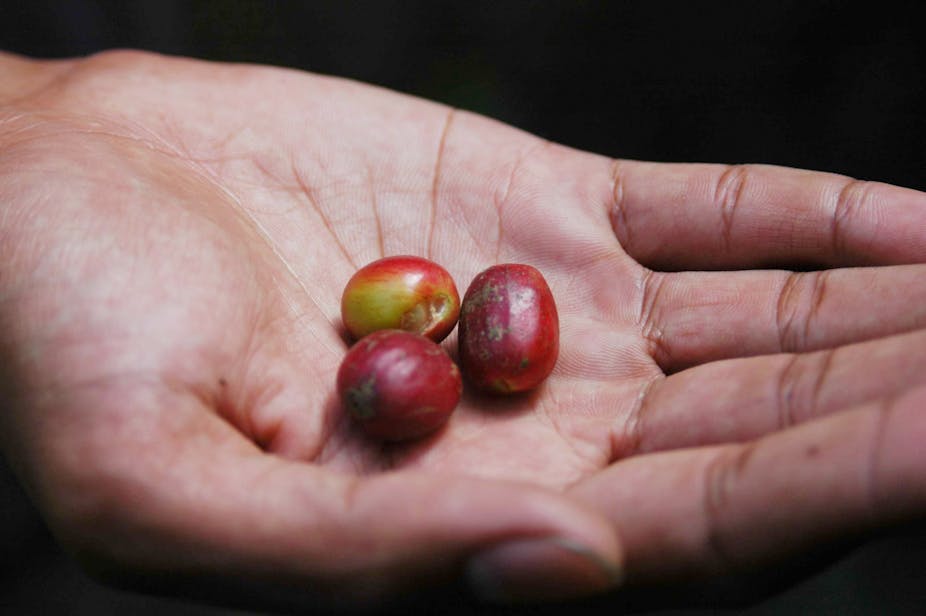Coffee prices are rising again, and you might be wondering how much more you’ll soon pay for your morning coffee.
Although coffee prices are fickle the fluctuations affect most of us very little compared with growers in developing countries, at the end of the supply chain.
You might also be wondering about the prospect of “peak coffee”. Peak coffee (like peak oil) is the point at which the world begins to run out of its global commodity.
But is the supply of coffee really going to run dry?
The good news for coffee consumers is that, empirically, there is little to suggest we’re in the midst of peak coffee.
Coffee production has consistently increased over the past 20 years, and there’s been no significant recent dip in global production.

This is true for robusta beans (Coffea canephora) and, to a lesser extent, the higher quality Coffea arabica.
But several coffee-growing regions have experienced a run of poor seasons, which is attributed to drought and unpredictable rainfall.
This has occurred across Central and South America, Africa and Asia.
Poor coffee seasons, coupled with the continual rise in coffee consumption, have led to demand exceeding supply and an increase in prices.
It is not yet clear whether these occurrences of drought and unpredictable rainfall are associated with climate change.
But several studies predict that the extent of cool, moist coffee-growing regions will indeed diminish due to climate change.
In the pursuit of favourable climate, plantations will also be forced further up mountainsides, which obviously has its limitations in terms of both land availability and the ability of farmers to migrate.
Like most of the globe’s resources, pressure is put on coffee supply when populations and demand expand. But with increasing demand and higher prices comes new suppliers to the market.

Coffee is a relatively easy market to enter. China, for instance is expanding coffee cultivation at a dramatic rate.
Nepal is also expected to significantly increase coffee cultivation over the next few years - not surprising, given the prospect of climate change and coffee’s need for increasing elevations.
It is difficult to predict the net effect of the two forces of poor seasons and the emergence of new coffee regions.
While some commentators talk of peak coffee, others talk of the next great coffee glut.
The last great coffee glut occurred 10 years ago, and led to a collapse in coffee prices. The situation was widely attributed to the financially-aided increase in coffee production in Vietnam, which almost overnight went from being a minor player to the world’s second largest coffee exporter.
In 2002, Oxfam described the consequences of low coffee prices as “a crisis destroying the livelihoods of 25 million coffee producers around the world.”
So, when the price of our cappuccino is low, it comes at a significant cost to the small-scale producers that depend on coffee as a major source of income.

Fluctuating coffee prices also have environmental impacts.
For example, rises in local coffee prices (which are basically global coffee prices transformed by currency exchange rates) have been shown to increase illegal deforestation in Sumatra.
In many parts of the world, including Ethiopia (the plant’s indigenous home), coffee is grown beneath a semblance of the original forest canopy, often with a variety of trees and shrubs.
While not as good as the intact forest, shaded coffee serves as habitat for a broad range of species and may help to connect otherwise isolated patches of intact forest.
But when coffee cultivation is intensified, forest trees and all competing shrubs are removed, and pesticides and fertilisers are more frequently applied – and the habitat value is greatly diminished.
These are the sorts of plantations that led to the coffee glut in Vietnam, and are currently expanding in China.
In Ethiopia, many farmers could be driven to convert to intensive coffee cultivation, abandoning shaded coffee, and even abandoning cultivation of staple crops such as corn, if the rewards are high enough.

The challenge is to address a balance between maintenance of livelihoods and preservation of natural environments.
Certification programs such as Rainforest Alliance and Fairtrade attempt to address this balance, but they cover less than 20 per cent of global coffee production.
Economist and author Tim Hartford believes that it will take far deeper changes in the globe’s financial divide before coffee farmers ever make a good living.
It’s worth remembering that the consequences of the price of our cup of coffee reach further than the change we give our barista.

